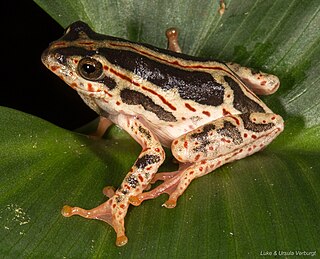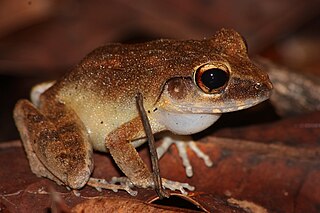
Probreviceps is a small genus of brevicipitine frogs with only six members. They occur in the montane forests of Tanzania, Zimbabwe, and possibly Mozambique. They are sometimes known as the forest frogs, forest rain frogs, big-fingered frogs, or primitive rain frogs.

Leptopelis is a genus of frogs in the family Arthroleptidae. They are found throughout Sub-Saharan Africa, excluding Madagascar. It is placed in monotypic subfamily Leptopelinae, although this subfamily is not always recognized. They have a number of common names, including forest treefrogs, tree frogs, leaf-frogs, and big-eyed frogs.

Mertensophryne usambarae is a critically endangered species of toad in the family Bufonidae. It is endemic to the foothills of the East Usambara Mountains, northeastern Tanzania.

Callimedusa atelopoides is a species of frog in the family Phyllomedusidae. It is known from Amazonian Bolivia, Brazil, and Peru, and is likely to be found in adjacent Colombia and Ecuador. Common name toady leaf frog has been proposed for it.

Hyperolius swynnertoni is a species of frog in the family Hyperoliidae. It is found in the southern portion of the eastern Zimbabwe uplands and adjacent Mozambique. It is also known as the Swynnerton's reed frog, with the subspecies "broadleyi" as the Broadley's tree frog or Broadley's forest treefrog.

The Cameroon forest tree frog, Leptopelis brevirostris, is a species of frog in the family Arthroleptidae. It is found in southern Nigeria, Cameroon, Equatorial Guinea, and Gabon. It is expected to occur in southwestern Central African Republic and in the Republic of the Congo, but no records have been confirmed from those countries.
Leptopelis parbocagii, also known as Lake Upemba forest treefrog or cryptic tree frog, is a species of frog in the family Arthroleptidae. It is found in Angola, the Democratic Republic of the Congo, Malawi, Mozambique, Tanzania, and Zambia. The specific name parbocagii refers to its similarity to Leptopelis bocagii.

Leptopelis parkeri is a species of frog in the family Arthroleptidae. It is endemic to Tanzania and known from the Eastern Arc Mountains. Specifically, it has been recorded from Uluguru, Udzungwa, East and West Usambara, Nguru, and South Pare Mountains. Common names Parker's tree frog and Parker's forest treefrog have been coined for it. It is named after Hampton Wildman Parker, a British zoologist and herpetologist from the Natural History Museum, London.
Cryptobatrachus fuhrmanni is a species of frog in the family Hemiphractidae. It is endemic to Colombia and occurs on all three Andean cordilleras: it is found on the eastern slope of the Cordillera Occidental, northern and eastern flanks of the Cordillera Central, and the western slope of the Cordillera Oriental. The specific name fuhrmanni honors Otto Fuhrmann, Swiss zoologist and helmintologist.
Pristimantis eremitus is a species of frog in the family Craugastoridae. It is found in the Cordillera Occidental in northwestern Ecuador from the Cotopaxi Province northward and on western slope of the Colombian Massif in the Nariño Department, extreme southwestern Colombia. The specific name eremitus is Latin for "lonely" or "solitary" and refers to this species being the only western-Andean species among its closest relatives. Common names Chiriboga robber frog and lonely rainfrog have been coined for it.
Eleutherodactylus rufescens, commonly known as the red peeping frog or Nevado de Colima chirping frog, is a species of frog in the family Eleutherodactylidae. It is endemic to Mexico and known from the region of the eponymous Nevado de Colima mountain in Colima, Jalisco, and further east and south in the Jalisco and Michoacán states. Its natural habitat is subtropical or tropical moist montane forests. It is threatened by habitat loss.
Probreviceps rungwensis is a species of frog in the family Brevicipitidae. It is endemic to Tanzania and is known from the Mahenge and Udzungwa Mountains as well as the Southern Highlands, including the eponymic Mount Rungwe, its type locality. It was first described as a subspecies of Probreviceps macrodactylus, but is now considered a full species. Furthermore, genetic data suggest that the nominal species includes more than one species.

Petropedetes johnstoni is a species of frog in the family Petropedetidae. It is endemic to coastal Cameroon and known with certainty only from few localities. For a period, Petropedetes newtonii was considered a junior synonym of this species, leading to a much broader distribution. The two species are now considered distinct, but information on Petropedetes johnstonisensu stricto is limited. Common name Johnston's water frog has been coined for this species.
Phrynobatrachus gutturosus, the Chabanaud's river frog or guttural puddle frog, is a species of frog in the family Petropedetidae. It is found in Democratic Republic of the Congo, Ivory Coast, Ghana, Liberia, Nigeria, possibly Benin, possibly Burkina Faso, possibly Guinea, possibly Mali, possibly Togo, and possibly Uganda. Its natural habitats are subtropical or tropical moist lowland forest, moist savanna, swampland, and intermittent freshwater marshes. It is threatened by habitat loss.
Phrynobatrachus phyllophilus is a species of frogs in the family Phrynobatrachidae. It is found in Sierra Leone, southern Guinea, Liberia, and Ivory Coast. Prior to its description in 2002, it was confused with Phrynobatrachus guineensis, one of its closest relatives. The specific name phyllophilus is derived from the Greek phyllon for leaves and philein for loving. It refers to on the close association of this species with leaf litter.
Phrynobatrachus stewartae, also known as the Stewart's puddle frog or Stewart's river frog, is a species of frog in the family Phrynobatrachidae. It is found in northern Malawi and south-central and western Tanzania. The specific name stewartae honours Margaret M. Stewart, an American herpetologist who wrote "Amphibians of Malawi" (1967) and collected the type series, originally identified as Phrynobatrachus gutturosus.

Cornufer papuensis is a species of frog in the family Ceratobatrachidae. It is found in the northern parts of New Guinea and in many surrounding islands, including the Bismarck Archipelago, D'Entrecasteaux Islands, Trobriand Islands, and Maluku Islands including Sula Islands and Seram Island (Indonesia). Common name Papua wrinkled ground frog has been coined for the species.
The Chimanimani stream frog is a species of frog in the family Pyxicephalidae found in Zimbabwe and Mozambique. Its natural habitats are subtropical or tropical moist montane forest, subtropical or tropical high-altitude shrubland, subtropical or tropical high-altitude grassland, and rivers. It is threatened by habitat loss.

The grey foam-nest tree frog, or southern foam-nest tree frog, is a species of frog in the family Rhacophoridae. It is found in Angola, Botswana, Kenya, Malawi, Mozambique, Namibia, South Africa, Swaziland, Tanzania, Zambia, and Zimbabwe, and possibly the Democratic Republic of the Congo and Somalia. Its natural habitats are subtropical or tropical dry forest, dry savanna, moist savanna, subtropical or tropical dry shrubland, subtropical or tropical moist shrubland, subtropical or tropical dry lowland grassland, subtropical or tropical seasonally wet or flooded lowland grassland, intermittent freshwater marshes, arable land, pastureland, rural gardens, urban areas, heavily degraded former forests, ponds, and canals and ditches.
Chalcorana chalconota is a species of "true frog", family Ranidae. It is endemic to Indonesia and occurs in southern Sumatra, Java, Bali, and a few smaller islands. Populations previously assigned to this species now belong to a number of other Chalcorana species, leading to the current delineation of Chalcorana chalconota with a much narrower range. This species is also known as the Schlegel's frog, brown stream frog, copper-cheeked frog, or, among with many other species, white-lipped frog.










